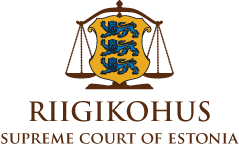 Riigikohus on Eesti Vabariigi kõrgeim kohus.
Riigikohus on Eesti Vabariigi kõrgeim kohus.
Põhiseaduse kohaselt on Riigikohus kassatsioonikohus ja
põhiseaduslikkuse järelevalve kohus. Riigikohtu pädevus
on sätestatud kohtute seaduses. 
Primary tabs
Administration of Courts
The first and second instance courts are financed from the state budget through the budget of the Ministry of Justice. Courts of the first instance and courts of appeal are administered in cooperation of the Ministry of Justice and the Council for Administration of Courts. The most important decisions concerning the court system and relating to administration of courts are first discussed and approved by the Council for Administration of Courts. So far, Estonia does not have special state institution or administrative authority which would be responsible for the courts' administration as a whole.
The Supreme Court, being an independent constitutional institution, administers itself and is financed directly from the state budget. Issues of court administration belong to the competence of the Parliament, the Supreme Court and the Ministry of Justice.
Administration of courts of first instance (districts courts) and courts of appeal (circuit courts) on daily basis falls within the competences of the Ministry of Justice.
The Minister of Justice:
- determines the territorial jurisdiction and location of courts of first instance and courts of appeal, as well as the total number of judges to be appointed to office at each of the above-mentioned courts,
- appoints the chairmen of district and circuit courts with the approval of the Council for Administration of Courts.
The Ministry of Justice may audit the organisational and financial activities of courts of first instance and courts of appeal.
The Supreme Court has the role of guaranteeing proper functioning of administration of justice in the court system, especially through organizing the work of judges’ self-government bodies. The self-government bodies of judges’ play an important role in the development of the court system through the decisions they take concerning the development of the judiciary. There are 5 such bodies in Estonia:
- Court en banc (comprised of all Estonian judges)
- Council for administration of courts
- Disciplinary chamber
- Judge's examination committee
- Judicial training council.
The majority of the self-government bodies function using the administrative support of the Supreme Court's officials, two of those bodies – the Court en banc and the Council for Administration of Courts are directed by the Chief Justice of the Supreme Court.
The Supreme Court performs the following functions in the administration of courts of lower instances:
- reviews the applications of candidates for judicial office and makes recommendations for running as a candidate for judge,
- resolves appeals filed against the decisions of the judge’s examination committee and the decisions of the Disciplinary Chamber,
- decides the commencement of disciplinary proceedings against the Chief Justice of the Supreme Court.

